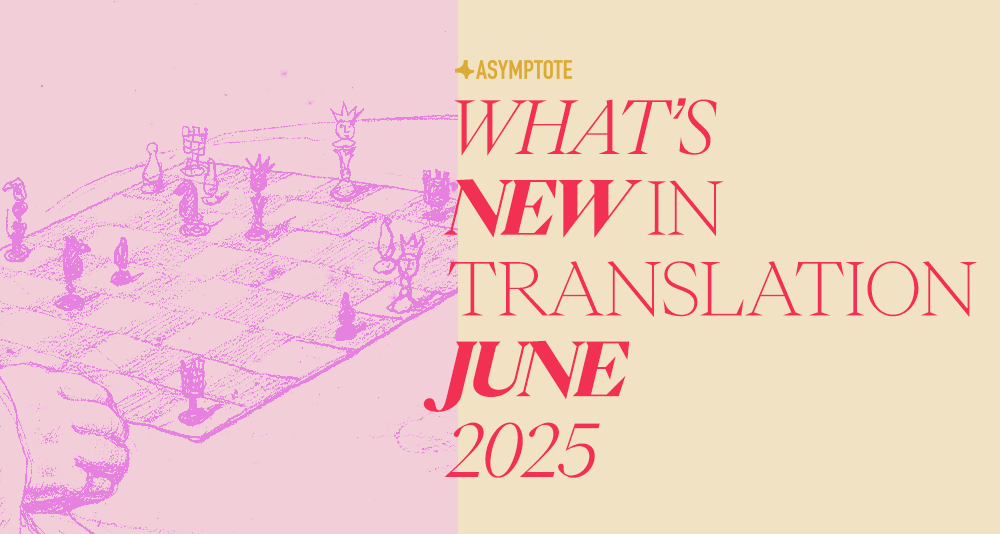This month, we’re delighted to be bringing twelve brilliant titles from eleven different countries. Find here the novelization of a famous chess match that reveals the greater geopolitical game playing us all; a summery fiction that melds the structures of nature and human architecture; a poetry collection rendering tender portraits of working-class women; a lyrical rewriting of a remarkable nun-turned-conquistador’s New World adventures; and so much more.
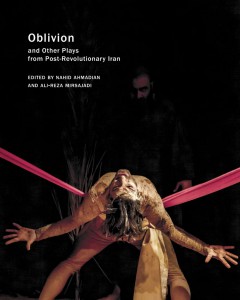
Oblivion: and Other Plays from Post-revolutionary Iran, edited by Nahid Ahmadian and Ali-Reza Mirsajadi, translated from the Persian by Nahid Ahmadian, Ali-Reza Mirsajadi, and Hesam Sharifian, Seagull Books, 2025
Review by Henry Gifford
In order, the five plays included in Oblivion: and Other Plays from Post-revolutionary Iran are set in Arabia in the fifth century AD (The Sacrifice of Senemar by Bahram Beyzaie); China in the second century BC (Oblivion by Hamid Amjad); Spain in the twentieth century (Dance of Mares by Mohammad Charmshir); somewhere (per stage directions and blank spaces left in the dialogue) in the city you’re in, on the day you’re reading it (The Child by Naghmeh Samini); and a laundromat in Los Angeles at three in the morning (Bird of Dawn by Sepideh Khosrowjah). Their narratives are of a hubristic yet indecisive king and his palace; imperial bloodshed and familial betrayal; sex and mariticide; an infant born on a migrant raft, protected at the border by three women who all deny being his mother; and three generations of Iranian immigrants, each with romantic trouble and divided identities. Some are epic, and others are everyday. None of them are set in ancient Persia or modern Iran, and only the first and last are explicitly about Persians or Iranians.
Yet these are, in fact, plays from the same country over the same quarter-century, from 1995 to 2019. The diversity of their settings and scale is a wise editorial decision intended to highlight the diversity of theater in Iran, but it also reflects a practical need of addressing contemporary, local problems obliquely under a censorship regime. What is more interesting is the collection’s consistency, and in particular the nonchronological approach taken within almost all of the plays. Oblivion, for example, begins with two siblings going to meet their adoptive brother after years apart; the encounter then extends over the course of the play as a frame to the story of their lives and their parents’, acted out in shadows on a scrim behind them. The formal blending extends this sense of collapsed time; as the editors’ introduction explains in great detail, shadow puppetry (khayāl-bāzi) is an old Persian form, here embedded within a more modern, European-inflected mode. The other plays are similarly mixed—traditional aspects and motifs cohering with contemporary themes and styles.
Every nation has history, but I wonder, reading the plays of Oblivion, if there is something about Iran—a young nation of an ancient culture—that has made its past more palpable, fraught, and vividly present.
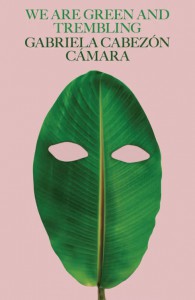
We Are Green and Trembling by Gabriela Cabezón Cámara, translated from the Spanish by Robin Myers, New Directions, 2025
Review by Eva Dunsky
“. . . From then onward, my life would behave like a boulder tumbling down a precipitous slope,” so says Antonio de Erauso, protagonist of Gabriela Cabezón Cámara’s We Are Green and Trembling. In this masterful picaresque novel, which follows Antonio on his adventures as he slashes his way through the teeming jungle in the New World, form follows function, and Robin Myers’s translation keeps pace with the galloping prose—as well as the many forms of Spanish—in Cabezón Cámara’s original. The result is language that also reads like a boulder tumbling down a precipitous slope:
Lurching and swift, brutish, blind, and deaf-mute I have lived, knowing nearly nothing of this world, dear aunt, but what a hunted animal can know; but what the deer downed by the she-jaguar and her cubs for breakfast can know, the buzzard for lunch. Yet I have not been a deer. I have been a fearsome beast, O aunt.
Speaking on the translation, Myers commented that her greatest challenge was “finding my own way to capture the different voices and registers throughout the book,” specifying that the difficulty was “not just to replicate the differences among these registers, but to find a sense of playfulness and autonomy in doing so that would honor the author’s own.”
As Antonio misadventures his way through the wild, he writes letters to the beloved aunt he left behind in Spain, contextualizing his present journey with his past as a young Basque orphan living in a convent and destined to become a nun—a fate he could not imagine for himself. Instead, turning away from “the brief lists of virtues for a woman,” the young acolyte shrouds himself in men’s clothes and sets sail for the new world, gradually losing his religious conviction beneath the jungle’s dense canopy.
In addition to being an imaginative portrait of the real-life explorer, We Are Green and Trembling is both a satire of Christianity and a reification of Guaraní creation myths. As Antonio falls out with the other conquistadors and comes face to face with the essential sacredness of the human and animal life that thrives around him, he gets wise to the hypocrisy of the Church’s brutal death campaign and frees two caged Guaraní girls, folding them into his own crusade. Their knowledge of the land proves vital, and as he nurses them back to health from the near-death conditions of their imprisonment, they initiate him into a way of living that’s symbiotic with the natural world around them. It is ultimately this ecological enlightenment that proves to be the final death knell of Antonio’s Christian upbringing, as he ruminates:
. . . beneath the earth the trees live another life, a life we cannot see, the life of their roots entwined, a web of them all sundered above, together down below. They rise up one by one, but they sustain each other. I see them because I myself am taking root, I lace myself to them as they lace me to themselves. . . . The world was not made in a single week, beloved aunt, it is made and unmade at every moment.
With its alluring rhythm, the relevance of Cabezón Camara’s novel to our current moment is inescapable; salvation will be found not in a patriarchal and prescriptive religion, but through ecological thinking and sensitivity to nature’s intelligences.
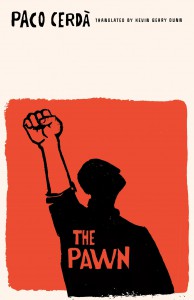
The Pawn by Paco Cerdà, translated from the Spanish by Kevin Gerry Dunn, Deep Vellum, 2025
Review by Jason Gordy Walker
Chess: it’s a serious game, one that comes down to life or death in Paco Cerdà’s The Pawn, a historical saga set during the Cold War. Rendered deftly by Kevin Gerry Dunn, the propulsive sentences move the novel along the throughline of a question: Are we all just pawns in a political game of divide and conquer?
Indubitably, that’s how Cerdà sees it. But this novel is dedicated to the pawns—their humanity and various walks of life, delineated with a journalist’s eye for candid, factual detail. After the tragic ending, the author delivers seven pages listing his many sources (including biographies, histories, newspaper archives, videos), and explains his method: “. . . not a single detail or word of dialogue would come from the author’s imagination. . . Like chess, the narrative chronicle genre leaves no room for cheating or shortcuts.” Dark, dispiriting, and blunt, yet packed with sympathy for his exploited, often misled characters, Cerdà’s book feels less like a novel and more like a powerful documentary film.
The overarching plot takes place in Stockholm, Sweden; it is the year 1962, and the brilliant, haughty American Bobby Fischer is facing the Spaniard Arturo Pomar—first grandmaster of Francoist Spain and now a lowly mailman—in a battle of wits that may prove to be one last chance at redemption. The match then unfolds through many short chapters, interspersed with episodes from the lives of other notable historical figures: Román Alonso Urdiales, a diehard Falangist who eventually faces Franco’s betrayal; James Meredith, the first Black man to enroll at the University of Mississippi; George Fryett, an E-4 Specialist in the US Army who gets captured by the Viet Cong; Dionisio Ridruejo, “fascist poet turned impassioned democrat”; and even Marilyn Monroe, whom Cerdà describes as “Hollywood’s toy, the icon of a system. . . .” These characters, just a sampling of what the book has to offer, interconnect through their broken connections to control-obsessed governments—of Kennedy’s United States or Franco’s Spain—and even the most despicable are portrayed in an even-measured light. Cerdà’s documentarian’s perspective, strengthened yet limited by its form (every person seems mostly defined by their relation to power structures), allows for distinct shades of nuance and grace, with some authorial judgement that invites further curiosity.
As The Pawn and its varied cast moves along the spaces on the board, Cerdà gathers his wealth of historical information on mostly forgotten Cold War icons, demonstrating the devastating consequences of people caught in the machine of tyrannical ideologies. From Franco’s executions of his own citizens, to systemic racism and classism in the hyper-capitalist US, to the Soviet Union’s paranoid communism and brutal military operations during the Vietnam War, these individuals rarely experience security, much less peace.
In life as in chess, the kings consider themselves to be the most important pieces and get treated accordingly. However—
There’s an Italian proverb that goes: after the game, kings and pawns get tossed in the same box. A closed box, without separate compartments based on rank, where dense darkness extinguishes all preeminence and blurs all distinction. Where there’s no awe for majestic crowns and no horror at the plain nudity of those who have only a base, a neck, and a head, defenseless against the onslaught of the game.
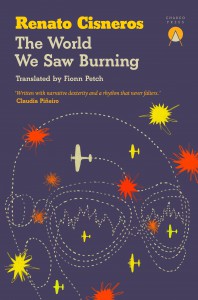
The World We Saw Burning by Renato Cisneros, translated from the Spanish by Fionn Petch, Charco Press, 2025
Review by Henry Gifford
One thing leads to another, until a man ends up killing his family. Renato Cisneros’s The World We Saw Burning tells the story of Matías Giurato Roeder, a young Peruvian immigrant of German and Italian descent, who serves in the US army during the Second World War. He happens to sail from Peru to New York to escape his violent father, in the hopes of one day visiting his mother’s family in Hamburg. He happens to befriend an American named Gordon Clifford on the boat, who adopts him in order to give him citizenship. He happens, a few years later, to take this adoptive father’s advice to join the army after Pearl Harbor, where he happens to distinguish himself as a bomber. One word at a time, he changes his name until he becomes Matthew Clifford Ryder, and when he is sent over Hamburg, no one suspects that this directive means asking him to bomb the people he had left home in hopes of meeting four years ago. He tries all he can, but in the plane, his finger on the button, he finds that “he can do nothing against the onward course of events.”
Matías-Matthew’s story is interspersed with a first-person narrative of a divorce in contemporary Madrid. There’s a pragmatic relation between the stories, but it’s somewhat arbitrary; a taxi driver tells the protagonist about Matías, but not until the end of the novel. There’s also a political and historical relation (the narrator is Peruvian, his ex-wife Erika is German) that suggests this novel as being primarily about the arbitrary and determinative nature of borders, the violence of immigration, and perhaps the lasting legacy of political violence. Of Lima, Berlin, and Madrid, Erika says: “Bombing never ends.”
All this is visible, but the strongest connection between the two stories is more broadly thematic. The fundamental difference the narrator sees between himself and Erika is their understanding of why things happen. He believes in the random sequence of events, coincidence, accident; she in “synchrony,” in meaning, in the notion that “everything happens for a reason.” Their divorce serves then as a domestic, modern analogue of the Roeder family’s tragedy, their diverging responses to it offering two potential lenses onto Matías’s airborne nightmare: Was the present always meant to be this way, or do things just happen?
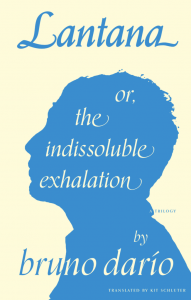
Lantana or, the indissoluble exhalation by bruno darío, translated from the Spanish by Kit Schluter, Ugly Duckling Presse, 2025
Review by Eva Dunsky
Lantana or, the indissoluble exhalation, by bruno darío, is a bilingual, posthumous collection of the poetic trilogy published during its author’s lifetime. Assembled for the first time in a single volume, the first section, “feast, fright,” sees a young man, the Inconsolable, falling in love with an older woman named Lantana. In the following “airsickness,” Lantana hosts a party and dies by suicide, and her corpse speaks from the afterlife in “raze.”
“Airsickness” is the heaviest book of the three; Kit Schluter describes in his translator’s note that for darío, the term refers to “the particular condition of alienation inherent to our times,” by which we are increasingly vulnerable to isolating technologies, breathing polluted air and witnessing our social fabric torn apart by “capital-fueled genocide.” These vicious sentiments pervade the books, but in the face of this destruction, the figure of the Inconsolable maintains a steadfast (if self-referential) curiosity about the world and the other people in it, which sustains him even as he becomes increasingly unmoored:
The existence of a holy spirit is a tautology. Every spirit is holy by definition.
And they do exist: desolate faces among gifts and smiles, covered with internal frost.
In a great variation of forms, the poems see the Inconsolable engaging with these holy spirits on his daily travails, meditating on the nature of love and friendship. Ultimately, the “indissoluble exhalation” that enlivens the self is tenderly described by Schluter (a close friend of darío’s) as the “truly poetic breath . . . which never dissolves or breaks down but stands eternally independent from the rest of metabolizable existence.” There’s sickness in the air, in the water, in the culture—it’s all increasingly difficult to metabolize, but even if poetry isn’t the antidote, at least it’s something (wonderful) to do in an increasingly unlivable world. Throughout the trilogy, it becomes clear that poetry’s draw is its existence outside the rigid binary of death/survival that darío continually challenges. As the Inconsolable and Lantana grapple with a mortality somewhat divorced from death, darío charts his own path forward and beyond, the poetic line carrying him through.
Terrifying, impossible, absurd—Lantana is brutally indifferent and indiscriminate, but never not at least a little bit funny. This collection is buoyed by its humor, juxtaposed right against the horror until the border between them fades:
I consider myself an inveterate feeler, but how can I live this way? How can I hold my breath underair, in our custom-built dungeon? I’m not asking you for an answer, which in any case would be go fuck yourself or get a job. Are events naked until the subject acquires them as experience? Things happen and they’re free until the subject perceives them, captures them. An idea can be naked if it’s unimaginable. Shall we go on?
I guess we’d better.
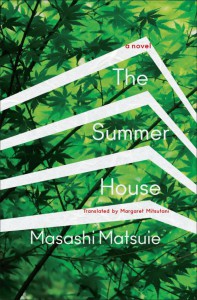
The Summer House by Masashi Matsuie, translated from the Japanese by Margaret Mitsutani, Other Press, 2025
Review by Jason Gordy Walker
Masashi Matsuie’s The Summer House may be a debut novel, but it’s as substantial as the best works of Haruki Murakami and Yoko Ogawa (whom Matsuie helped during his career as an editor at the Shinchosha Publishing Company), earning its author the prestigious Yomiuri Prize. Now in a lean, propulsive English rendered by translator Margaret Mitsutani, the novel takes on a simple plot: a small architecture firm, led by Shunsuke Murai, is designing the National Library of Modern Literature at a summer house in the mountain village of Aoguri, competing against a large firm headed by rival architect Funayama. Through his quiet, pensive, and clear prose, Matsuie elevates this story to an elegant structure founded on the nature of architecture, the architecture of nature, and affections both platonic and romantic.
The narrator, Tōru Sakanishi, is an apprentice architect in his early twenties, and he describes Murai—also known as Sensei—both up close and at a distance; although Murai had studied under Frank Lloyd Wright, his employees reason that Sensei seems more influenced by Gunnar Asplund, a Swede known for the Stockholm Public Library. As demonstrated in this detail, the novel’s conflicts can be found in quotidian matters; the characters debate each other over ideas and designs, work towards deadlines, and struggle to draw their lines correctly. Tōru develops his craft alongside a cast of likeable intellects: his instructor Uchida, a furniture designer, cook, and motorcyclist; Iguchi, the office manager; Kawarazaki and Kobayashi, the firm’s aging veterans; Ms. Sasai, expert calligraphist; the level-headed and calm-voiced Yukiko; and Mariko, Sensei’s niece and Sakanishi’s love interest, a talented pianist whose energy and sex appeal add a layer of distraction to the office.
Strong descriptions of buildings and Japanese landscapes uphold the novel’s peaceful tone. Indeed, despite the novel’s bittersweet ending and a few mishaps elsewhere (a storm, a power outage, a breaking and entering, an elderly neighbor in poor health), the majority of its pages makes for a tranquil read, which I can appreciate—how many more shock-and-awe novels do we really need during these loud times? Sakanishi, a longtime bird enthusiast, mentions “[w]oodpeckers, grosbeaks, thrushes, flycatchers. . .” from the novel’s outset, and, later, the kogera, a very small woodpecker that makes “. . . a faint khii trailing behind it.” From a less talented writer, such images would feel saccharine, but with Matsuie they simply feel accurate.
By the time the novel sees Tōru and Mariko become lovers (a development they hide from their coworkers), Matsuie—like the fictional authority figure, Murai—has proven himself to be a sensei of understatement and pacing. By the final chapter, Sakanishi notices that the summer house’s katsura tree, which always leaves a lasting impression, has become “. . . tall enough to overshadow the roof.” Yet, some things remained the same: “What hadn’t changed were the leaves . . . they were bright yellow, from top to bottom.” As an ode to the great visionaries of structures—functional, humble, and refined—and a meditation on a formative period in a young architect’s life, The Summer House proves to be more stunning than the ritziest commercial work.
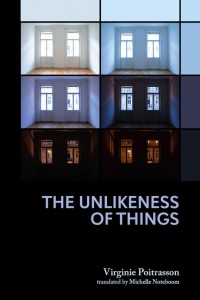
The Unlikeness of Things by Virginie Poitrasson, translated from the French by Michelle Noteboom, Litmus Press, 2025
Review by Xiao Yue Shan
Be grateful that the divide remains a mystery to us—the one between the body and everything else. As Virginie Poitrasson proves in this inimitable collection, that’s where our capacity for thinking becomes the most tangible, where we have the most control, and thus where our minds are the most formidable. “Things have an internal equivalent in me; they arouse in me a carnal formula of their presence,” Merleau-Ponty said when monitoring that odd journey between the actual transforming into the imaginary, when objects seem to learn from our bodies and our visions, making it so that the mind is not simply some aimlessly wandering thing, but remains constantly on a retrieval mission to offer its findings for our corporeal understanding. This transition is not the material of scientists; poets are most suited to monitor this channel, and Poitrasson is better than most. In her poems, the “things” shake loose their regularity and are restored with physiognomy, incandescence; we sit with these poems in the centre of the world’s scales, the physical on one end and the metaphysical on the other, keeping it in balance.
Trees, lamps, bikes, they wear something. Their costumes are made of paint, varnish, bark, dust, damp and rust. But there are also naked things, which are invisible. And when I come down to the street, as if naked, I belong to those invisible things.
The Unlikness of Things is Poitrasson’s first book to be published in English amongst her seven in French, and it is a seismic introduction to a poet whose reconciliation of physical and psychic material reveals the sublimity of both. In Michelle Noteboom’s living translation, these poems are relentless in their performance and articulation of physicality, lending its formal ideals to the formless. Time and space are concretized by the way we may understand them as weight—the span of a minute or an hour being known by the growing pain of an outstretched arm holding, or the fragrance of a mimosa passing into the nose and sculpting one’s presence within it. Deleuze once said something to the effect that when the hand reaches out to feel a body, one is able to comprehend and substantiate the quality and shape of that body without being aware of the movements of the hand; it’s an immediate and certain truth, seemingly without mediation. Poitrasson reaches out with language and traces the surfaces and textures, and we are given that same tactile absolution. It is not that she describes what she feels, but what she is doing as it feels: “My body is no longer a border, I pour into the room. Have become one with the chairs.”
It is incredibly powerful, then, when one realizes that what catalyzed this need to redress the demarcations, to turn the straight line of a body’s precipice into a constellation of interactions and negotiations, is death: “When she’s no longer there, I sit cross-legged in the evening, eyes closed, and I feel her living elsewhere in the darkness.” The transformations that we’ve been privy to throughout this collection culminate to transgress all that solidity makes us vulnerable to; it is the rejection of a final form and a study of how continuation can be possible. Here, the beloved is gone, yet there is still so much substance in how Poitrasson senses their presence. It is as real—though flightier—as their aliveness. So it is not just that the poems enable travel via a transposition of one’s own physicality to other materials, but that the disappeared and the no-longer can also borrow from our carnality to exercise a living of their own.
“Are you on the other side? What’s over there on the other side?”
“Yes, I’m on the other side. And it’s a whole other side from which I can still see you.”
Poitrasson’s original French title is Le pas-comme-si des choses—the “not-like-that” of things. “Unlikeness” is a beautiful substitute, and far more elegant than the straight English iteration, but there is something very direct in that clunky phrase, as if to say: elsewhere death is so final, but it’s not-like-that here.
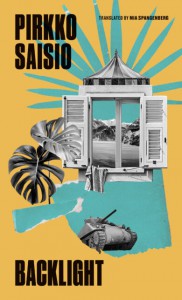
Backlight by Pirkko Saisio, translated from the Finnish by Mia Spangenberg, Two Lines Press, 2025
Review by Eva Dunsky
In Pirkko Saisio’s Backlight, the protagonist—also named Pirkko Saisio—has to contend with an overwhelming list of oppressors: her overbearing literature teacher, God himself, her father, and the Finnish Communist party, all of whom are (according to her) conspiring to ruin her life. In one of this multi-layered novel’s timelines, Pirkko is marooned in the gaping years between childhood and adulthood, stuck in her parents’ house without a room to call her own (the one promised to her being occupied by her grandfather). She is listless and agitated, full of an unshakable shame whose source she can’t pinpoint, and spends most of her time escaping reality through books.
When a Finnish professor suggests she has what it takes to be a writer—as long as she follows her own voice rather than getting distracted by the vagaries of the moment or inane adolescent concerns—Pirkko sees a way forward. The novel beautifully captures this moment of artistic awakening; whereas literature has long been a tool for orienting herself, she’s only just awakening to the possibilities of her own language, and how she can use it to articulate herself amidst the drudgery of family life. Noting this tone of youthful passion, translator Mia Spangenberg mentions “channeling [her] own past teenage angst to convey the discomfort and rage Pirkko feels.” Her English-language rendering is as intimate as it is fluid: “I’m reminded of something the translator Suzanne Jill Levine said, essentially that you look inside yourself to see what you have in common with the characters and use that to bring the characters and story to life.”
The novel’s other timeline flashes forward a few years to 1968, when nineteen-year-old Pirkko—lured by the thought of Julie Andrews—begins work at a Swiss orphanage, where she’s dismayed to find that neither children nor employees burst spontaneously into song. Instead, as left-wing civil rights protests envelop Europe, she’s stuck feeling homesick in this oddly isolated and faraway place. When she comes face-to-face with a queer relationship (between two nuns, no less), it sparks her own feelings of repressed queerness, and Pirkko sets off to find out: “Is what I think Tante Irma and Tante Dolores are doing generally possible? And is it common?”
As the second book in Saisio’s Helsinki trilogy—preceded by Lowest Common Denominator and followed by The Red Book of Farewells—this novel sees the fictional Pirkko emerging as a writer herself, attempting to make sense of ambiguous realities and contradictory truths. At this point, she still has the rest of her life—and her art—to figure it out.
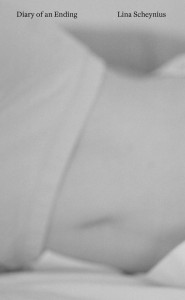
Diary of an Ending by Lina Scheynius, translated from the Swedish by Saskia Vogel, Prototype, 2025
Review by Henry Gifford
It’s a shame that when love ends, the only person who really understands is the one you really ought not to talk to. Everyone knows it; everyone tries anyway. By the time Lina Scheynius begins Diary of an Ending, she’s long stopped trying—ostensibly having moved on from her “six-year on again and off again relationship”—and has finally come to a far enough remove to treat it as a subject. Through essays written in English and diary extracts translated from the Swedish by Saskia Vogel, we get a few details of the relationship itself, but as the title suggests, Scheynius is more concerned here with the ending.
The picture isn’t attractive; her boyfriend “A” is unfaithful, belittling, a classic asshole at best—and Diary of an Ending begins when he leaves an unprecedentedly loving breakup letter on her pillow in a hotel room. In the first line in her diary after receiving the letter, Scheynius writes, “SADNESS. FREEDOM.” That conflict is characteristic. What follows are six months of emotional turmoil: abandoned by a person she loves for no good reason, neither of them quite managing to go through it alone.
What makes Diary of an Ending interesting is not so much in the personal details, but in the work’s examination of time and change; it is “an ending,” not “a breakup.” The form is a fascinating approach to this fundamental issue, interweaving texts from different parts of the timeline and punctuated by pairs of beautiful, ambiguous, black-and-white photographs (of Scheynius’s longtime profession). The diaries can be obsessive, frankly sexual, spiteful, forlorn, full of repetition and sharp vacillations—as such private writings often are—while the essays are more assured, mostly hopeful, less dramatic, though still heartfelt. When she thinks about having children in the diary, she writes “I dream of sperm. His, ideally. . . The greatest gift of all”; but in the essays, the thought is transformed: “I explored all options—egg freezing, sperm gifted from men or bought online, becoming a single mother.”
In this respect, Vogel’s translation is integral to the book (which hasn’t appeared in Swedish). The voices of the diaries and the essays are not only separated in time but by language, and the two genres appear both distinct and interrelated. Through their braiding, one can observe how the tone of reaction gradually shifts to one of retrospection. There is no need for straightforward description; through the emotional tenor alone, we can feel Scheynius moving upon the path to independence.
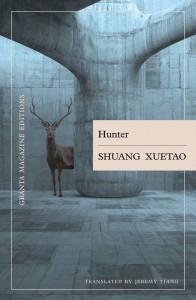
Hunter by Shuang Xuetao, translated from the Chinese by Jeremy Tiang, Granta, 2025
Review by Alex Tan
Hailing from the deindustrializing northeast of China—what is sometimes christened its Rust Belt—Shuang Xuetao typically writes of disaffected protagonists, ordinary folk who labor to live with the legacies of mass unemployment and collective immiseration in the shift toward market reforms. In Hunter, his sharp, vigorous, and frequently ironic vernacular prose (rendered smartly in Jeremy Tiang’s controlled translation) depicts the dark side of that “economic miracle,” an underbelly of clandestine crime and buried grudges awaiting fruition; the gritty cast includes knife fighters, pugilists, martial artists, and gunmen.
Under cover of a seedy darkness, history often rears its ugly head, whether in the pain of a generationally transmitted heart disease, the long shadow of the Cultural Revolution, or the scar of the Japanese occupation. One character’s sentiment might be the whole collection’s ethos: “. . . he represents the power of the past, which makes him the assassin of the present, a witness she has no defence against.” In this layered sentence, too, we see Tiang’s judicious choices at work; he’s opted to preserve the rhythmic parallelism between the clauses (“power of the past” and “assassin of the present” echo the beat of the original Chinese), while the repeated 是 in Chinese (the copula “is”) is creatively dispersed into the verbs “represents” and “makes”. The result in English is an accentuated causal relation, like a chemical equation satisfyingly balanced.
Across the disparate pieces, unrelinquished holdovers linger as surreal vestiges of enchantment. An especially memorable story foregrounds a visitor from another world, who threatens to annihilate the whole city unless he can hunt down the precious five-word sentence that his grandfather once uttered. In another, a forbidden sword manual houses the “evil” secret of generating a ghostly shadow-self that will outlive one’s death. These traces of magic are often delivered matter-of-factly—seemingly cosmic but ultimately unremarkable ripples that barely disrupt the textures of quotidian reality and the onward march of historical time.
Yet language itself seems a fleshy substance molding life and fate; it is to the potent, sometimes monstrous materiality of words that Shuang repeatedly pays loving tribute. No wonder so many of his narrators are writerly figures or art-makers to varying degrees of failure and unfulfillment, struggling to triangulate the proper distance between fiction and the “altar of reality.” And if “all we ever do is deceive one another,” then maybe what they long to worship is a mirage—necessary, and vanishing upon approach.
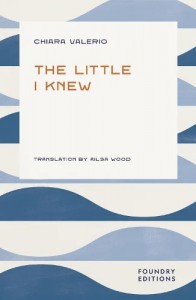
The Little I Knew by Chiara Valerio, translated from the Italian by Ailsa Wood, Foundry Editions, 2025
Review by Eva Dunsky
The year is 1974, and in a small southern Italian town called Scauri, a woman named Vittoria dies suddenly in the bath. Her death is considered an accident, which makes sense—she’s not so young and has always seemed happy enough, but most importantly, she lives in a town where silence is mistaken for politeness. Despite having been a truly beloved presence, the townspeople simply mourn and move on—except for Lea.
Lea is a local lawyer, one of the few from her social class (an incredibly rigid fixture in 1970s Italy) to obtain a degree and find a white-collar job. She’s inquisitive by both nature and profession, and after the shock of Vittoria’s death, she decides to learn more about the mysterious woman’s life. The novel’s spare prose invites the reader to speculate as Lea or another townsperson might; with so much implied or unsaid, what do people actually know about Vittoria? What brought her to Scuari all those decades ago? Her ambiguous relationship with Mara, the younger woman she lives with, has always raised eyebrows, but her friends are too polite (or afraid of the potential response) to inquire. Only in death does the web of omissions and silences around her ex-husband and her past become clear. Through the mystery, Valerio grapples with themes of identity, shame, and repression: how well can we truly know and appreciate a person when so much of their life is obscure to us? What if some of us would rather turn away from those hidden parts?
The Little I Knew beautifully weaves a small town’s capacity for repression with the lack of language and will to acknowledge queer relationships; it’s a novel built around the multifarious, contradictory silences that say as much as the dialogue. As Lea remarks: “The town’s memory is inexhaustible. Time after time it’s unreliable, but it’s always accurate.”
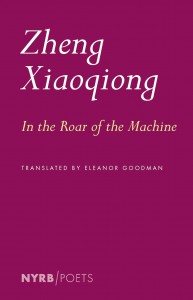
In the Roar of the Machine by Zheng Xiaoqiong, translated from the Chinese by Eleanor Goodman, New York Review Books, 2025
Review by Jason Gordy Walker
Zheng Xiaoqiong’s In the Roar of the Machine collects poems from 2006 to 2016, arranged across five sections that survey the migrant worker experience in China; the cruelty of global economics and geopolitics; and the dividing lines between women, industrial laborers, impoverished ruralities, and the discriminatory capitalist machine exploiting lives for fleeting material gains. Comprised of long lines and gritty images of factory life, these poems carry their downtrodden and resilient characters with empathy and transgression, capturing industrial processes and China’s natural beauty in turn:
My body contains a vast open plain, a train
is travelling across it, but autumn is in its deep
suffering twilight, and I follow the train’s
meandering path, planting a thousand hawthorn trees in the wilderness
Eleanor Goodman’s translations showcase these poems with the delicacy of original English compositions, paying close attention to diction (“you hold tight to Japanese silk roses, German gears, imitation callipers”), their urgent and minimally punctuated rhythm, and the overall serious mood: “I speak this sharp-edged, oiled language / of cast iron—the language of silent workers / a language of tightened screws. . .” Formally inventive and approachable, such poems give voice to the voiceless—especially women, whose few options seem to be hard labor, marriage, or prostitution—and Zheng ponders them most compassionately in the third section, “Woman Worker.” In poems of just one or two pages, she portraits women and girls who endure pain on multiple levels—physical, mental, emotional, spiritual, societal—and hones in on perspectives that otherwise would be overlooked. Several of these poems are titled after a specific individual that Zheng remembers—“Zhou Hong,” “Liu Meili,” “Li Juan,” “Shu Miao”—as the poet memorializes their lifelong hardships via plainspoken vocabulary, revealing complex situations. In “Hu Zhimin,” the titular character who was a “. . . one-time colleague . . . reduced to a hotel / prostitute,” Zheng describes her early death, after which:
a man from her village told me then described
how she died he said she sent so much money home
said her family home was expensive her own brothers used
her body to make money to buy a house in the village and open a shop
he said after she died her brothers didn’t even come
to bring her ashes home she couldn’t be buried in her family plot
she had sold her body she was dirty she’d ruin the fengshui of the family home
No matter how smooth its execution, this poem is not a light read, and one ought to savor it slowly to fully grasp its dark, melancholic undercurrents. Zheng/Goodman’s choice of “fengshui,” along with the fact of the family’s rejection, strikes me as utterly devastating; another young woman, after trying her best to survive in a society pitted against her, is used and discarded as if her life had no value. Yet Zheng proves to us that Hu, as well as the other women and girls she describes, are the actual foundations of civilization: human individuals with real hearts and desires.
The collection also includes two long poems: “The Mutating Villages,” which chronicles the interplay between Chinese villages and nature, and “In the Hardware Factory,” which forms the entire final section:
The reality is princes and party bosses, tax collectors and the political system, on rainy days
they hold meetings to discuss the country’s yin and yang, the roads, ideology, how there’s a need
for more email attachments and ordinances, how trees need steel altars, how the moon will be reborn
Outspoken and unafraid to critique insatiable Molochian power structures, Zheng Xiaoqiong distinguishes herself with this collection as one of our time’s most important poets: a strong voice that uplifts nature and humanity, laments and honors the victims of a rigged system, and sings in a language that transcends national borders.
Eva Dunsky is a writer, teacher, and translator. Her fiction and nonfiction have appeared in Joyland, The Los Angeles Review, The Rumpus, Bookforum, and Pigeon Pages, among others, and she’s at work on a novel. Read more of her writing here.
Henry Gifford is a freelance copy editor and translator.
Xiao Yue Shan is a poet, writer, editor, and translator.
Alex Tan is a writer in New York. They’ve been assistant managing editor at Asymptote Journal for three years, where they frequently review Arabic literature in translation. Other essays have been published in Words Without Borders, The Markaz Review, ArabLit, and Full Stop Quarterly; some of these writings can be found at https://linktr.ee/alif.ta
Jason Gordy Walker is a poet, translator, and prose writer. His translations of poems from the Norwegian of Rune Christiansen are forthcoming at B O D Y (Czech Republic) and Cordite Poetry Review (Australia). Walker was the February 2025 Artist-in-Residence at Newnan ArtRez in Georgia, U.S.
*****
Read more on the Asymptote blog:

